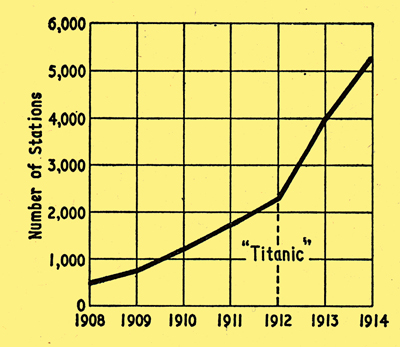|
A catastrophe which stirred the minds of men-and still does so-was the sinking of the Titanic. That great liner, believed to be unsinkable, struck an iceberg on her maiden voyage and sank in a few hours. Over 1,500 lives were lost, but some 700 were saved by ships summoned by wireless.

Increase in the number of the world's licensed stations between 1903 and 1914
That 'epic tragedy of the sea', as we called it, was to have far-reaching effects. In earlier shipwrecks lives had been saved by wireless, but the part it had played in the Titanic disaster fired the public imagination; no longer did anyone doubt its value. America quickly passed a law to regulate wireless communication and, at long last, ratified the International Convention. Wireless men had become benefactors of humanity and, if our pages can be taken as reflecting their attitude, felt they 'had never had it so good'. Indeed, over-confidence began to creep in.
A grandiose, and what now seems over-optimistic, 'Imperial Wireless Scheme' for linking the units of the British Empire was planned and a contract between the Postmaster-General and the Marconi Company was signed in July. A few extracts from the specification will give some idea of the giant spark stations proposed: 'Capable of transmitting to the distant station at any time of day or night. ...Wavelengths as great as possible within the limits of 17,000 and 50,000ft. ...Aerials over 3,000ft to 8,000ft long, supported by tubular masts 300ft high. ...Prime mover to be a steam turbine of between 1,300 and 2,500 hp.
A name that has constantly recurred in our pages since the beginning -and happily still recurs- is that of H J Round, one of Marconi's engineers. In an article on the strength of atmospherics in relation to signals, Round described the use of a Fleming diode as a valve voltmeter to measure voltages set up by the X's--certainly our first mention of what we would now call electronics. Round has played a prominent part in many important developments.
High-speed automatic telegraphy was discussed. The transmitter was keyed by a Wheatstone machine and, for reception, there was the choice of photographic or phonographic methods. The phonograph, which allowed better discrimination between signals and X's, seems to have won the day; before long, speeds of 100 words per minute were demonstrated.
Heaviside's theory of wave propagation, enunciated some ten years earlier and now expanded and championed by Eccles, became the subject of quite violent controversy. It is pleasing to record that we came down editorially on the right side-but very cautiously: 'at the moment there is a disposition to accept the hypothesis put forward by Dr. W H Eccles as yielding the best explanation of the observed phenomena'.
Direction finding, a brand-new application of wireless, now appeared. Thanks to the large size of the pair of fixed loops" used in the original DF gear, sufficient signal pick-up was obtained to give fairly useful ranges without amplifying valves.
Throughout the early period wire-less was bedevilled by patent litigation. During this year some sort of agreement seems to have been reached between Marconi's and their rivals Telefunken; actions and counter-actions with Siemens, who exploited the German system in Britain, were called off.
|